×
Save 20% On Your Purchase!
Use code SAVE20 at checkout to save on your purchase today from my Herbal Shop!
×
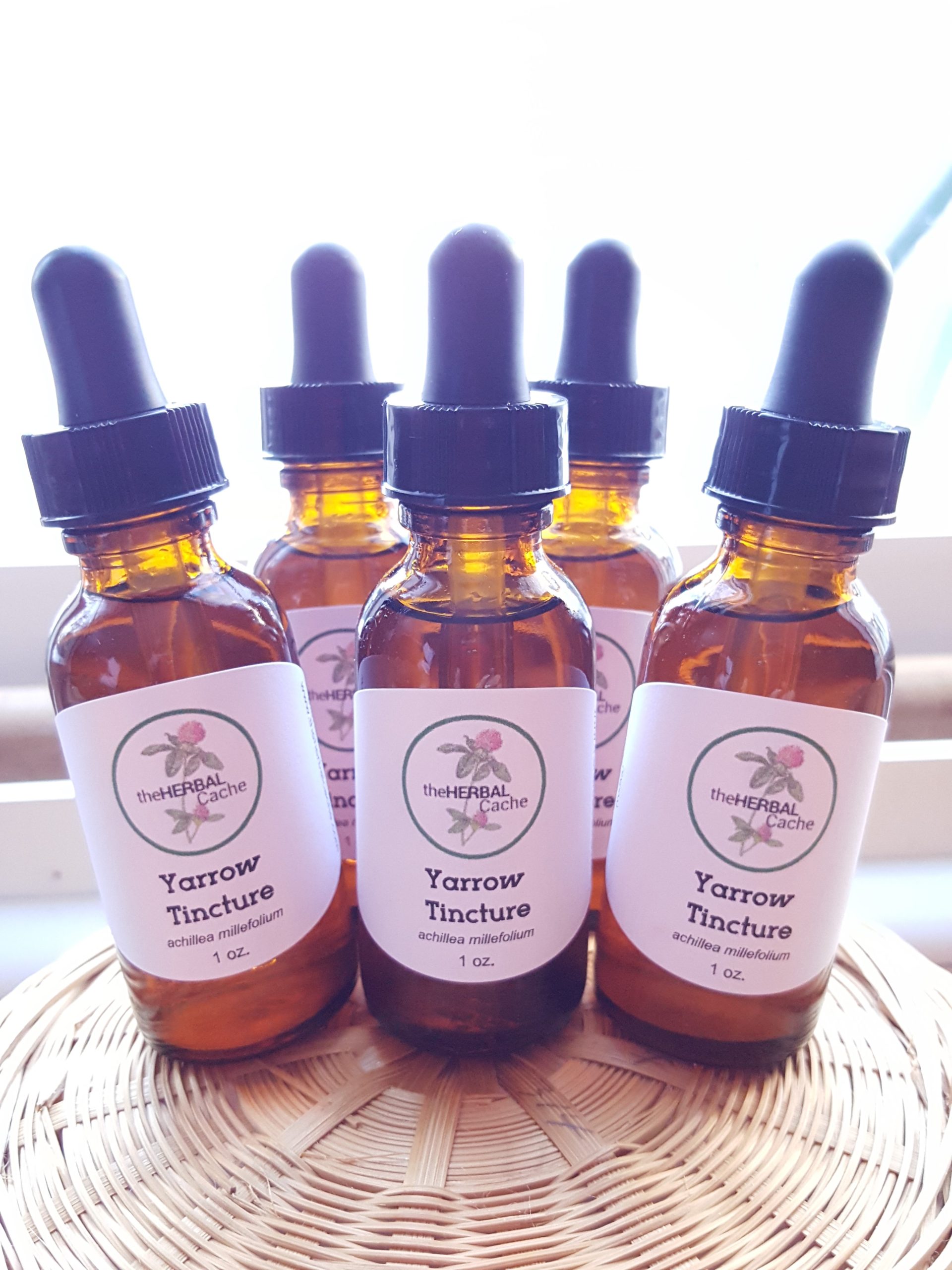

“An anthology is like all the plums and orange peel picked out a cake.” Walter Raleigh
Eat orange peels?
Now most of us will drink orange juice or eat the inside slices of an orange. But the peel? Too bitter!
But before tossing that orange peel into the garbage, continue reading and be amazed!
The peel has so much to offer us in terms of medicinal properties and keeping us healthy. It has been used for thousands of years to treat different ailments.
Orange peel contains a large amount of Vitamin C and is a powerful antioxidant.
So lets learn a bit about how orange peel is good for us, make a cup of orange peel coffee, look at ways to get orange peel into your diet, and lastly, check out other ways to use up those orange peels.
In Need of Organic Orange Peels?
You can save the peels from organic oranges you purchased and dry them yourself. Easy peasy.
Or you can purchase them from Mountain Rose Herbs, who stand for organics, fair trade, sustainability and more.
Orange peel, along with other citrus fruits, have been used for thousands of years as medicine.
It contains flavanoids, Vitamins A, C, B5 and B6, calcium, riboflavin, thiamine, niacin, folate and dietary fiber.
Lets look at the 21 ways orange peel has been used over the years to help with overall health and how you can benefit.
1. Diarrhea
2. Indigestion
3. Constipation
4. Cleansing
In Traditional Chinese Medicine (TCM), the orange peel has been used for hundreds of years to help with gas, bloating and other digestive issues.
The orange peel contains pectin, which is a beneficial carbohydrate that the good bacteria in your gut feed off of.
5. Colds
6. Coughs
Because of its antibacterial, antifungal and antiviral properties, orange peel is a great for warding off cough and colds. It helps in getting excess phlegm out of the lungs.
7. Weight Loss
8. Obesity
9. Athletic Performance
A team of scientists in Taiwan researced the effects of four different orange peel varities, and found that they remarkably reduced the production and accumulation of triglycerides in fat cells.
10. Cholesterol
When taking in large amounts of orange and orange peel, the HDL increases, while the LDL decreases, which is great for those with high cholesterol.
11. High Blood Pressure
The potassium in orange peel plays a huge role in lowering the risk of high blood pressure.
12. Anxiety
13. Stress
14. Hypertension
15. Depression
Studies are now showing that by just inhaling the aroma of orange and orange peel, can have an uplifting effect on people.
16. Arthritis
17. Rheumatism
Orange peel contains powerful anti-inflammatory agents that help with swelling, redness and inflammation.
18. Asthma
19. Oral Health
20. Hangovers
21. Poor Circulation
So how can you get more orange peel into your diet? Let’s start with a cup of Orange Peel Coffee and then look at more ways to use those peels.
This coffee recipe is not only easy to make, but so good to drink!
Coffee has always been associated with caffeine and a morning pick-me-up. This cup of freshness is much more.
Smelling the citrus aroma while the orange peel is steeping in the hot coffee is just up-lifting.
Are you ready for some?
Here is the recipe for Orange Peel Coffee. I’ve taken it from HERE and adapted it to my tastings. That’s what makes this recipe so wonderful! You can adjust it to your likings.
Orange Peel Coffee
Ingredients:
Directions:
Enjoy my fun little video below on making Orange Peel Coffee!
Besides eating orange peel, there are a number of other uses for orange peel, so don’t throw it out! Unless it’s into the compost pile.
Here is a list of uses:
https://www.motherearthliving.com/cooking-methods/citrus-peel-medicine-coffee
https://www.webmd.com/vitamins/ai/ingredientmono-908/sweet-orange
https://www.motherearthliving.com/health-and-wellness/citrus-peel-medicine
https://www.linkedin.com/pulse/25-proven-health-benefits-orange-peel-tea-dr-paul-haider/
Yarrow is one of the world’s oldest medicinal plants and has been used for centuries. It was found among other medicinal herbs in a Neanderthal burial site in Iraq, which dates from around 60,000 BC.
Throughout history, it has been used for treating wounds, hence its common names “soldiers’ woundwort” and “staunchweed”.
Achillea millefollum
The genus, Achillea, was named after the Greek hero, Achilles, who used plant extracts to treat soldiers’ wounds in the battle of Troy. Millefolium means “a thousand leaves”.
The most common and well known use for yarrow is healing wounds. It also helps to control the bleeding of lacerations, puncture wounds, and abrasions.
Because of yarrow’s anti-inflammatory and antiseptic oils, astringent tannins and resins, it possesses excellent wound healing qualities. It also contains silica, which will help in repairing damaged tissue.
Achillea millefollum has antibacterial and antimicrobial so it will help in preventing any infection from setting in.
Make yarrow a staple in your first-aid kit. You never know when it will come in handy.
Yarrow is considered a bitter, which makes it a great partner for digestion. This in turn helps the body absorb more nutrients. It also helps with poor appetite due to low digestive secretions and general inflammation that makes tissues not function well. It has a slight affinity for the gallbladder and liver.
This plant can also help if you get food poisoning, by getting the toxins out of your system.
Yarrow has been used throughout history in relation to blood. It both activates blood platelets and breaks up coagulated blood. By thinning the blood, it moves congestion in the portal vein, the pancreas and the lungs.
It also stimulates the bone marrow and increases white blood cell production.
Achillea millefollum may also lower blood pressure by moving blood to the skin and easing the burden on the heart.
Yarrow is an astringent, and because of that, it is wonderful for varicose and spider veins. It astringent properties help tighten and tone the walls of the veins. This is the key ingredient in my ever popular varicose vein cream. Check out my blog post on varicose veins to learn more.
Place some crushed leaves up against the aching tooth and it will help relieve the pain.
Yarrow is used to protect the skin from excessive sun or wind. It can also help to clear up skin acne.
The astringent properties make it a go-to herb when one is hit with diarrhea.
Because it is a diuretic, yarrow promotes urine production and flow, which helps let out excessive fluids and toxins through enhanced urination.
The diaphoretic actions of yarrow can help move toxins out of the body through sweating, which helps the body to break fevers. By relaxing the skin, it will open the pores to allow copious sweating and the release of toxins.
Yarrow fights infection, helps with nausea, stimulates sweating, and lowers fever. Through thinning the blood and increasing circulation, it also helps congested people breath better. A classic cold and flu remedy is a combination of yarrow, peppermint and elderflower drunk hot.
Yarrow has been used successfully to treat asthma attacks through thinning the blood and increasing blood flow in the lungs.
If you ever get a nosebleed, all you have to do is pick a few fresh leaves and rub them between your hands to bruise them, releasing the aromatic oil. Roll the leaves into a nasal plug, insert into the affected nostril and leave until the bleeding completely stops before gently removing the plug.
But beware – yarrow can also cause nosebleeds as well. It is one of those plants that can cause what it cures. Hence, one of its nicknames is “nosebleed”.
Menstrual Cycle
Yarrow contains sterols, which have actions similar to hormones, and aid in balancing the menstrual cycle. So it is applicable in both extremely heavy or very scanty (and absent) menstruation. It may also be used externally as a sitz bath for painful cramping during menstruation.
In Sweden, they sometimes use yarrow in place of hops when brewing beer. It is said to be more intoxicating that way.
Yarrow has many uses in the garden. It’s small, delicate flowers are wonderful for bringing in bees and butterflies.
Yarrow is a great companion plant. It’s root secretions strengthen and protect nearby plants and help them become more disease resistant.
The roots of the yarrow plant bind loose soil together, thus helping prevent erosion.
Every garden should contain at least a clump of yarrow to help maintain a healthy ecosystem.
Many of the superstitions and incantations that involve Yarrow are focused on finding one’s partner. Many traditions suggest that the seeker, mainly young girls, would sew an ounce of Yarrow in a piece of their clothing or place it under their pillow before going to sleep.
“Good morrow, good morrow,
To thee, braw yarrow,
And thrice good morrow to thee;
I pray thee tell me today or tomorrow
Who is my true love to be.”
Yarrow is viewed by some as having a protective quality from “bad vibes” or that feeling of “everyone is against me”.
By using it as a flower essence or having the actual plant, it can help protect one from the negative outside influences one may have.
I wildcraft my yarrow in central Minnesota and make tinctures. They are available for purchase HERE.
https://wildfoodsandmedicines.com
All photos are the property of theHERBAL Cache, unless otherwise noted.
I love seeing virginia waterleaf coming up because I know that spring is here and winter is behind me. Here in central Minnesota, it is one of the first spring ephemeral plants to emerge from the cold ground. Sam Thayer calls it an “optional ephemeral” because it is abundant in the spring, but becomes sparse in the summer months.
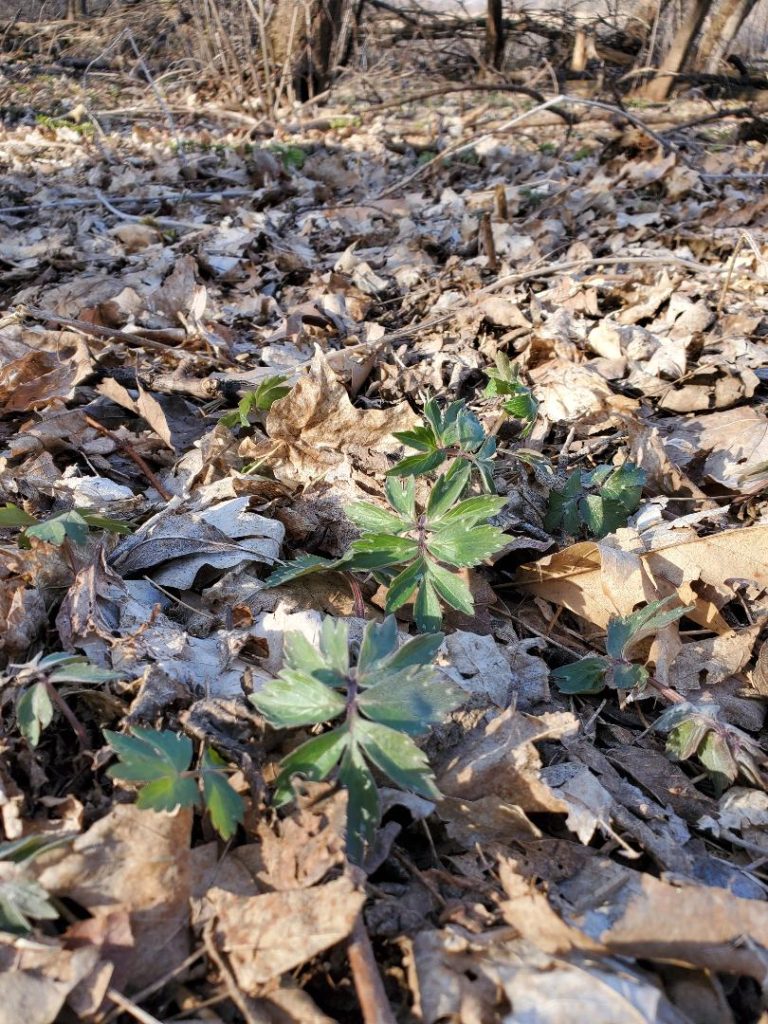
Virginia Waterleaf emerging from under the dead leaves in early April.
Hydrophyllum virginianum
The generic name, Hydrophyllum, is Greek for “water leaf”. Hydro is from hudor or hydor, which is “water”, and phyllum is from phullon or phyllon, which is “leaf”. This name also refers to its wetland habitats. The specific epithet, virginianum, is Latin for “of Virginia”, where it was first studied.
You can easily identify virginia waterleaf in the spring because of the distinctly spotted leaves, giving it the appearance that it is stained by water drops. Virginia waterleaf is one of the most prolific varieties, and it flourishes far past Virginia into areas such as Minnesota.
Virginia waterleaf is a herbaceous perennial in early summer. It can be found mainly east of the Mississippi River, but it has western cousins, the California waterleaf (Hydrophyllum occidentale) and the Pacific waterleaf (Hydrophyllum tenuipes).
Although this plant is fairly competitive with other plants, there are some areas, such as New Hampshire in which this is becoming endangered.
Bees and white-tailed deer love this plant for gathering nectar and eating.
Other common names for this species are Brook Flower, Burr Flower, Eastern Waterleaf, Indian Salad, John’s Cabbage, Shawanese Lettuce, Shawnee Lettuce, Shawnee Salad, Virginian Waterleaf, and Waterleaf.
Virginia waterleaf can be found growing in wet, wooded areas. It prefers shade. It likes a a moist humus-rich soil. Slugs are particularly fond of this plant and will soon destroy it if given a chance
The plant grows in a clump like format with limited spread. The root pattern is rhizomatous with underground stems sending roots and shoots along their length. The clumps can easily be propagated in the spring.
This plant is considered a nice groundcover by many gardeners.
In early spring, Virginia waterleaf can be easily identified by the spots on the leaves, appearing to be waterdrops, hence the name. The leaves are deeply lobed, with jagged edges, and get darker as the plant matures.
It flowers in May to early June and seeds in July and August, lasting 3-4 weeks. The flowers form in dense clusters and are are white to dark violet in color.
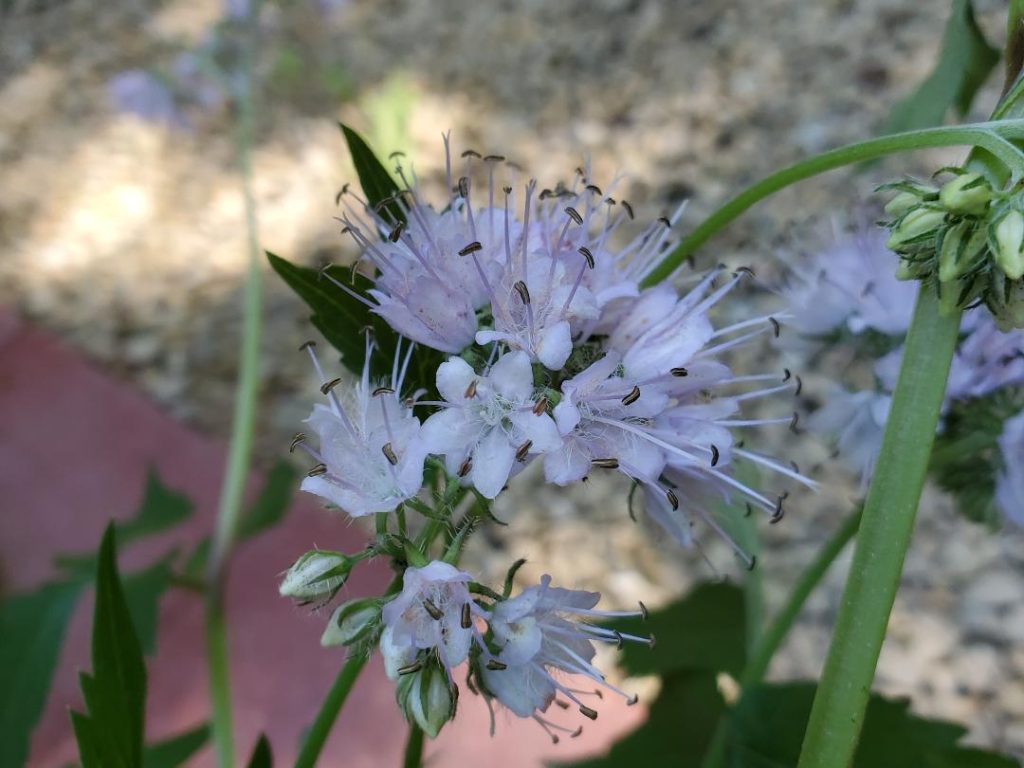
The leaves are alternate with the stems being slightly jointed. The stem is covered with dense, stiff hairs. Where the plant divides, the stem is more red or purple in color. The plants get about 2 feet tall.
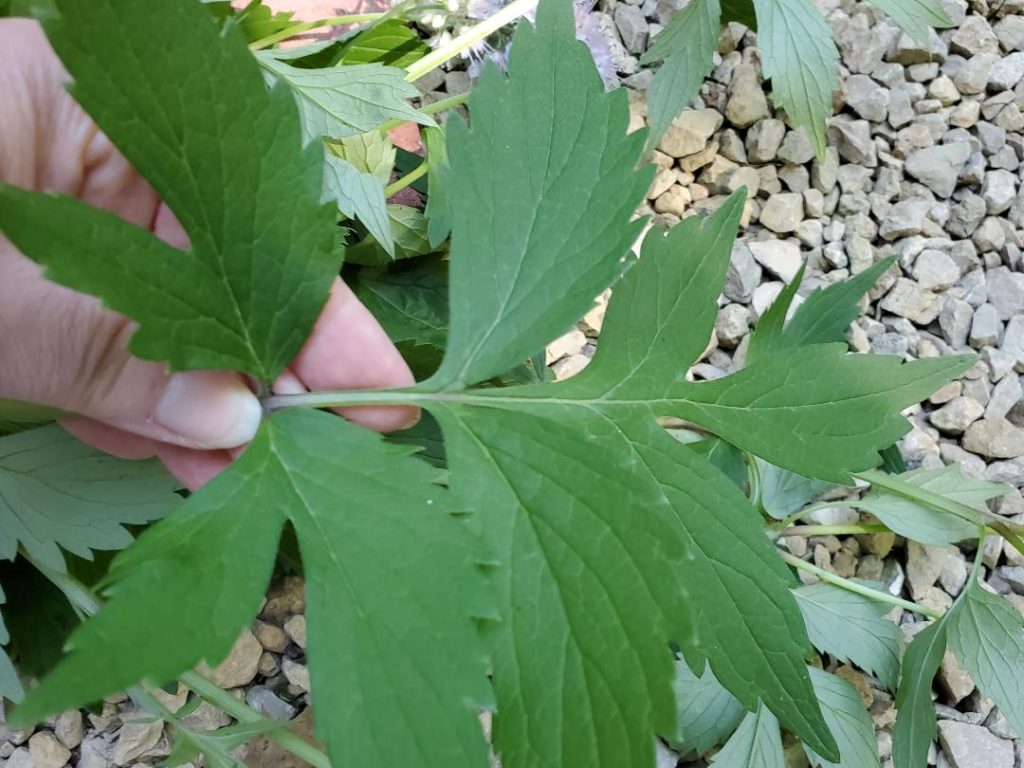
Both the Native Americans and the early European settlers used this plant.
Known also as Indian Salad, the leaves taste a bit like parsley and are good in salads this time of year or in soups as a potherb. The leaves are also good fried in fat or oil when they are tougher.
The leaves can be eaten when young. They have a rather bland taste and are a nice addition to any leafy salad. The leaves do have a slightly fuzzy texture, but when mixed with other greens, you don’t notice it. The older leaves can be eaten as well, and are more like spinach. According to Sam Thayer, they are to be eaten like most greens, used as a side dish or snack, not a main dish.
The flowers and flower buds can be eaten. Add them to a salad for decoration and to eat! The buds are similar to the raabs of garlic mustard and bittercress. Mix them with the leaves and some other greens and they make a fun, textural addition to the salad.
The leaves and flowers can be eaten raw or cooked. When cooking, it is recommended to boil twice with fresh water to remove some of the bitterness. The cooked leaves and shoots can be served with salt, pepper, butter, or vinegar. The leaves and shoots are best eaten before the flowers emerge.
Some Native American tribes fed the roots to their ponies to fatten them and to shine up their hair.
Minnesota herbalist Matthew Alfs says virginia waterleaf is a first-rate astringent and sadly ignored by herbalists. He says it is his go-to remedy for those with oral sores.
A tea made from the roots as an astringent, can be used in the treatment of diarrhea, dysentery etc. A decoction, or the chewed root, has been used as a wash for cracked lips and sore mouths.
Historically, it was used for pain. The Menominee used the roots for chest pain and the Ojibwe used it for back pain.
Using this plant in tea form is the most common usage, but it can also be made into a tincture. I prefer the tincture form because it has a longer shelf life.
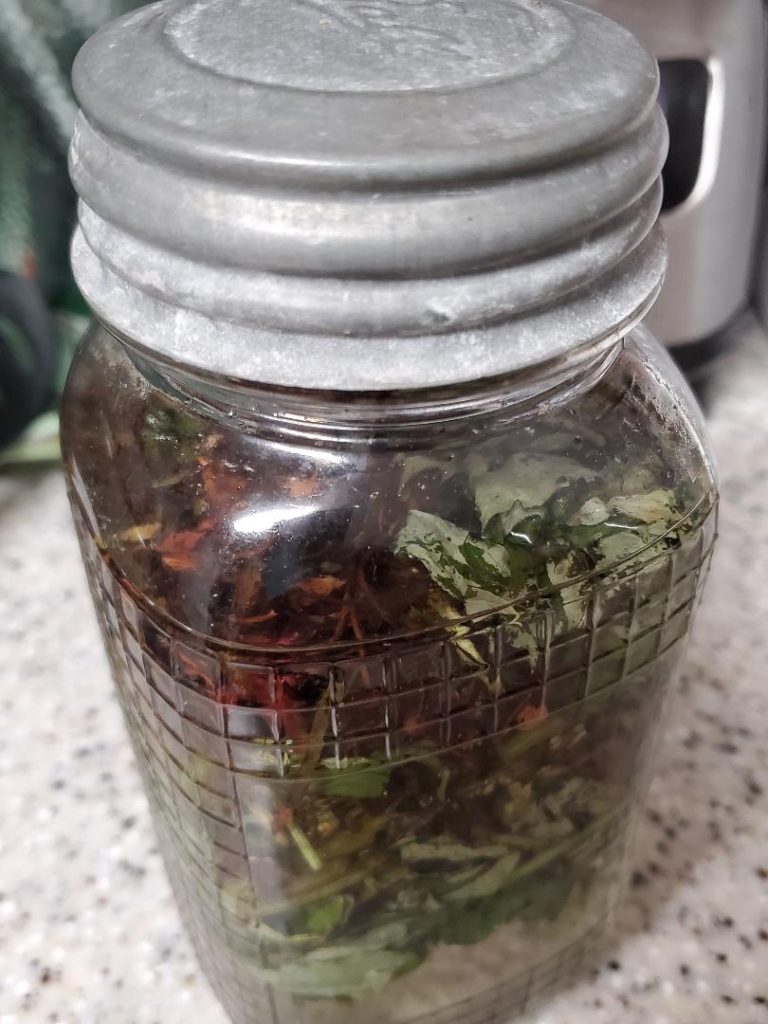
I use the entire plant to make a tincture. This way I get the whole plant’s synergy into my medicinal liquid extract.
I suggest you keep a watch for this hidden little gem of a plant. In the early spring, take a nibble on a leaf and see what you think. Or just admire the ornamental flowers sticking up above the stems. Either way, I think you’ll find that this plant has a personality all its own!
Thayer, Samual (2006). The Forager’s Harvest: A Guide to Identifying, Harvesting and Preparing Edible Wild Plants. Birchwood, WI: Forager’s Harvest
Alfs, Matthew (2013). Edible and Medicinal Wild Plants of the Midwest. New Brighton, MN: Old Theology Book House
http://www.naturalmedicinalherbs.net/herbs/h/hydrophyllum-virginianum=virginia-waterleaf.php
http://www.wildfoodies.org/EasternWaterleaf.htm
https://pfaf.org/user/Plant.aspx?LatinName=Hydrophyllum+virginianum
https://practicalplants.org/wiki/Hydrophyllum_virginianum
https://www.ediblewildfood.com/virginia-waterleaf.aspx
http://www.illinoiswildflowers.info/woodland/plants/va_waterleaf.htm
Glechoma hederacea
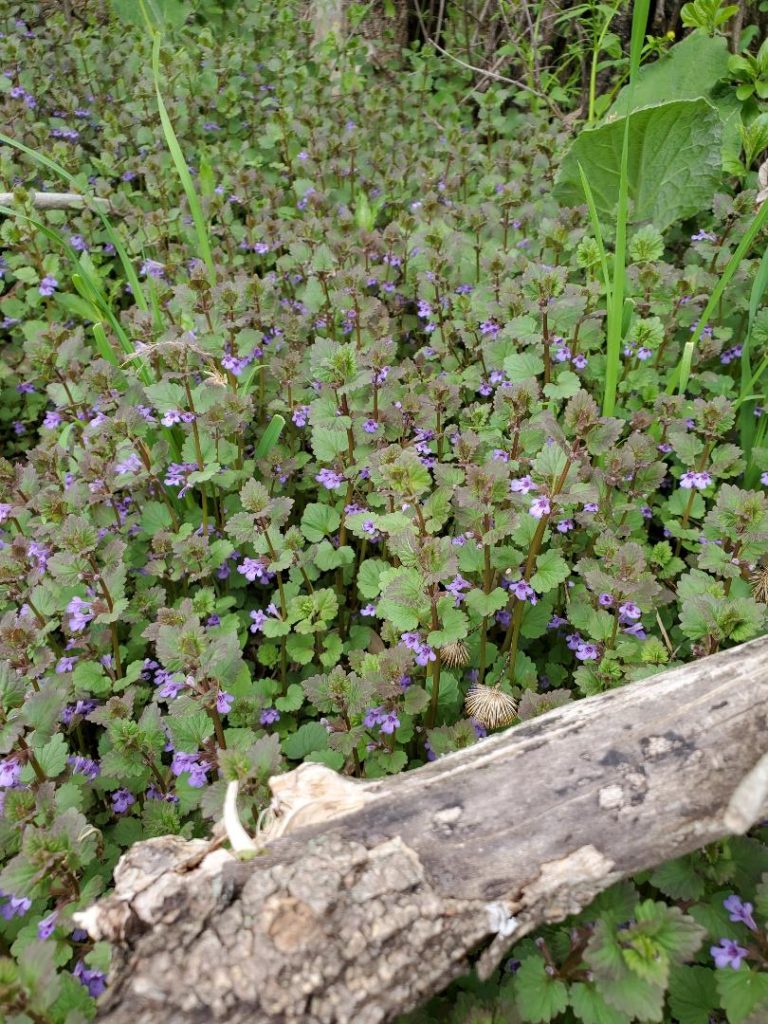
Creeping Charlie, also known as ground ivy, has had a bad rap for quite some time. Because it “creeps” up in lawns and yards, in places where it is not wanted, it has become a nuisance for many people. Once it is established, it is very hard to get rid of.
Creeping charlie is native to Europe. European settlers brought it to North America for plant medicine and as a ground cover. It grows rapidly from seeds and spreads via stolons (creeping stems). You can find it growing in moist, shady areas.
One of my herb mentors, Lise Wolff, said “Perhaps we should restore it to its original Latin name, Corona terrae; ‘Earth Crown,’ as it is truly like a garland over the ground.”
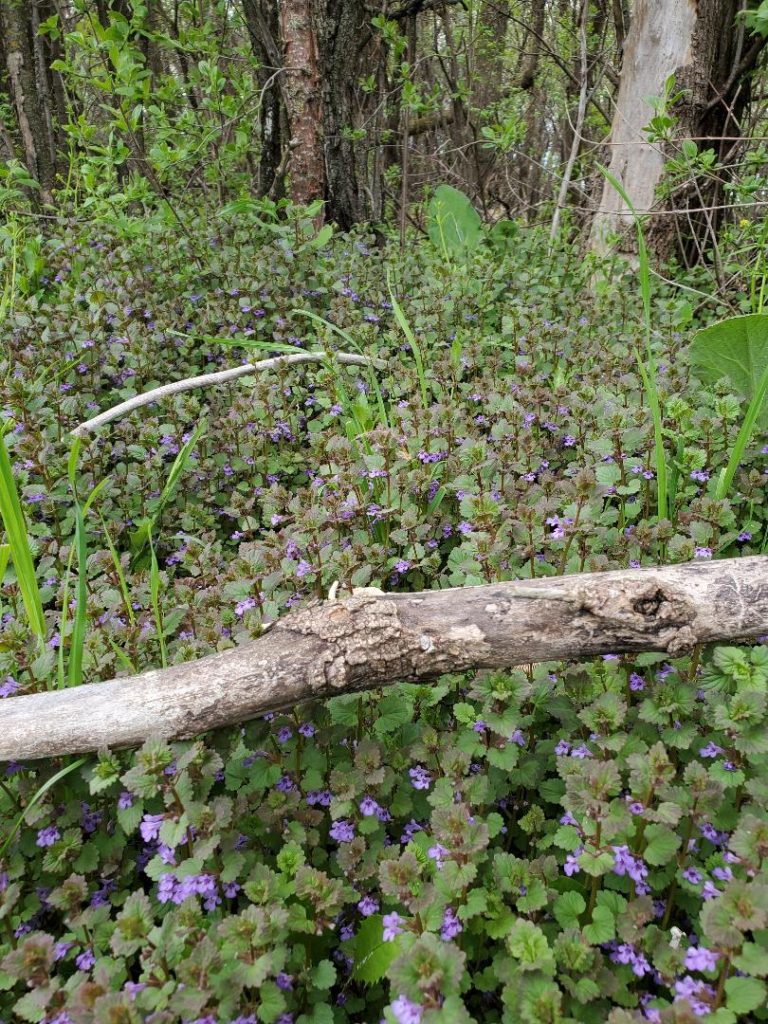
This plant is part of the mint (Lamiaceae) family. The leaves have a mint-like flavor and can be tossed into salads to add extra flavor. Create a seasoning salt to put on pastas or meat dishes.
Just like spinach, the leaves can be sauteed and added to omelets, soups, rice, etc. Pair them up with dandelions and make a wild salad! Use it for seasoning meats or vegetables. It can also be found in beer recipes – check this one out, Belgium Wild Beer!
The use of this plant dates back to the first century where it was considered a panacea (cure-all). The medicinal uses for Glechoma hederacea, or creeping charlie, are as extensive as the plant itself. The list includes congestive headaches, toothache, indigestion, bloating, gas, earaches, sore throats, bronchitis, chest colds and even depression.
It also has an affinity for ear issues, such as tinnitus. Matthew Wood tells of his use of ground ivy in a case of chronic bronchitis believed to have originated years before in a middle ear infection.
Creeping charlie is becoming more well known for its ability to draw out heavy metals. It has historically been used to help with “Painter’s colic,” a variety of lead poisoning resulting from constant exposure to leaded paints. A number of fellow herbalists use it for mercury poisoning that comes from cavity fillings.
Here is a video from Spiraea Herbs, “Charlie Ain’t All Bad“, that goes over more benefits of ground ivy, or creeping charlie.
I wildcraft creeping charlie and make a tincture out of it. This way I can store it for a long time and have it available when needed. I pick the top 75% of the plant and use the stems, leaves and flowers.
Creeping Charlie makes an excellent nectar for the bees and other pollinators, along with other spring flowers. Look closely and you’ll see the busy little bees!
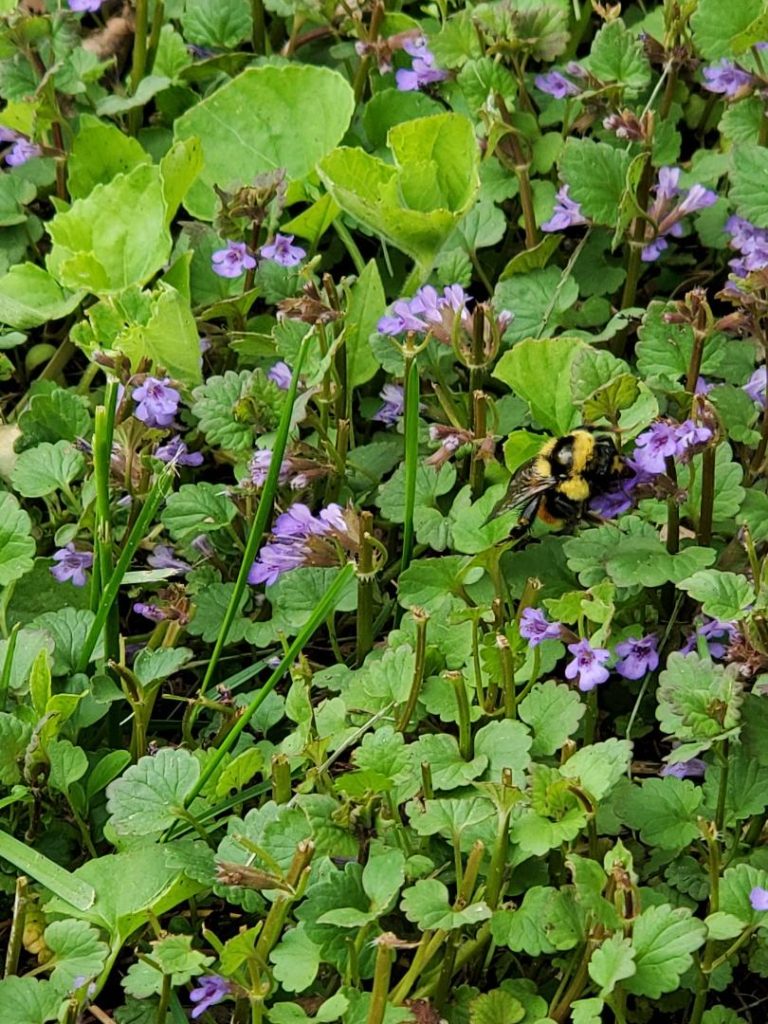

Varicose veins are part of getting older for some of us. As our bodies start taking the tole of our past years, it starts to show physically. You could say that is a sign of learned knowledge. But, for most of us, we would rather not show so many signs of getting older.
For now, lets take a look at one physical feature that many people are concerned about, and those are varicose veins. We’ll look at what they are, how they come to be and some natural ways one can try to subdue them.
Varicose veins are enlarged veins that have pushed themselves outward, just below the skin. They are most commonly found on the legs and feet, yet can affect any vein in the body.
Most are harmless. They are just a cosmetic issue for some people.
For some, varicose veins can be painful or sore. They can also cause issues for blood circulation. That can bring on swollen ankles, itchy skin and achy limbs.
Veins are continually working against the forces of gravity as they push blood back to the heart. Veins must be kept healthy and strong to maintain this level of work.
There are “valves” in the veins that push the blood back to the heart. Valves and muscles work together to get the job done. So if the muscles weaken, so do the valves.
As the valves and muscles weaken, blood starts to pool in these areas, which leads to varicose veins.
A variety of things can cause the weakening of valves and muscles. Some of those include obesity, being sedentary (which causes muscles to weaken), standing for a long period of time, pregnancy, menopause, aging, genetics and walking.
Poor blood circulation is also key in varicose veins, and a number of other health issues. Lack of concentration and low energy levels can also be due to poor blood circulation. Here is an article from The Lost Herbs, DIY Lost Circulation Booster, that can shed more light on this topic and a way to correct the issue.
The primary symptom of varicose veins is visibility. They become swollen, misshapen veins on ones legs. Some people will also have pain, heaviness and achiness near these veins.
Swelling can also occur in the lower legs and ankles after standing for periods of time.
In severe cases, the veins can bleed and ulcers may form.
According to WebMD, varicose veins can sometimes be genetic, and women are twice as likely to develop them over men.
About 23% of Americans are affected in some way.
There are a number of things a person can do to help control and lessen the issue. The Mayo Clinic suggests exercise, elevating ones legs and wearing compression stockings.
Also, losing weight or maintaining a healthy weight can help minimize or prevent them as well.
Surgery is an option for those where lifestyle changes aren’t improving the condition or there is just too much pain. More information on surgical procedures can be found here.
Using herbs and plants is another way to deal with this issue.
One can look to herbs and plants to help with varicose veins in a natural way.
A number of herbs that can be used to minimize the effects of varicose veins are known as astringents. They help by tightening the tissues and getting them back to their original state, as best they can.
Some of these herbs include:
(helichrysum italicum) is named after the golden yellow flowers of the plant, and comes from the Greek words helios meaning sun and chrysos meaning gold. A common name for it is Immortelle.
Helichrysum has many medicinal properties and is known for its restorative and rejuvenating properties. It helps heal scars and supports cell growth by encouraging the recycling of dead cells and stimulating production of new ones.
This yellow flower can also be used to help with inflammation and clears blood clots by liquefying/thinning them.
Helichrysum is an anti-oxidant as well.
(aesculus hippocastanum), also known as buckeye in some parts, or conker tree in Europe.
Horse Chestnut supports blood circulation, thus helping those with varicose veins. As an astringent, it helps to tone vein walls which, when slack or distended, may become varicose, hemorrhoidal or otherwise problematic.
Aescin, a constituent found in horse chestnuts, performs an antioxidant function and has a general vasoprotective role by protecting collagen and elastin (the two chief proteins that form the structure of veins). There are multiple clinical studies showing that horse chestnut helps in reducing inflammation, alleviating circulatory problems affecting the legs and reducing varicose veins.
You can find our more about how horse chestnuts help with varicose veins in this article, “How to Treat Varicose Veins with Chestnuts“.
(quercus alba) is a tree native to North America and was used by Native Americans for many conditions. Throughout history, it has been known as a symbol of strength and endurance.
White oak is an astringent, due to its high level of tannins, and helps with inflammation and skin conditions, such as varicose veins.
It is also an antiseptic, so helps control infection internally and externally.
White oak also contains quercetin, which helps in strengthening the capillaries and veins.
Did you know you can grind the acorns into a flour? Pretty cool!
(Salix alba) has been used medicinally for over 5000 years. It is native to Europe and Central Asia.
The bark is known as being the original pain reliever because it contains salacin, which the body converts to salicylic acid. Thus if helps reduce fevers, pain and inflammation. It takes a little longer to work, but lasts much longer then aspirin and has less side gastronomic side effects due to the large amounts of tannins that protect the stomach.
The inner and outer barks have slightly different concentrations of compounds for different ailments.
Willow bark’s high concentration of antioxidants make it very beneficial for the health of the skin. It increases blood flow to the skin, which helps to reduce wrinkles and age marks.
(Hamamelis virginiana) is a fairly common shrub found in North America. Native Americans used it to help treat skin irritations and tumors.
Witch hazel is a great skin treatment because of its astringent properties. It helps with stretch marks, wrinkles, acne, hemorrhoids and varicose veins. It is also good for itchy skin when dealing with chickenpox, eczema, bug bites and poison ivy.
Witch hazel’s ant-inflammatory properties also make it a go-to for diaper rash and sunburns. Regular application helps in healing the damaged skin quicker.
Daily use of witch hazel helps to kill bacteria living on the skin and supports cell growth. It also helps to remove excess oil from the skin.
(Achillea millefolium) originated in Europe. It can now be found in many parts of North America. The Greeks used yarrow over 3000 years ago to treat wounds. The genus name, Achillea, honors the Greek hero Achilles; who reportedly used yarrow for himself and for his soldiers as a treatment for battle wounds. Yarrow was also commonly used during the Civil War to stop wounds from bleeding.
When used topically, yarrow is wonderful for helping with skin issues, such as rashes, hemorrhoids, varicose veins or broken wounds. It supports blood circulation, reduces blood stagnation and helps to tone vein walls with its astringent properties.
Herbal Products or DIY
One can make their own creams or ointments to help with varicose veins by using some of the herbs mentioned above. One place to purchase these herbs is at Mountain Rose Herbs.
If one can’t or doesn’t have the time to make a cream or ointment, I offer a wonderful cream for varicose veins that not only helps minimize them, but softens and hydrates the skin as well.
Another way to utilize herbs in controlling or minimizing varicose veins is by using tinctures topically. Put the tincture directly on the varicose veins and let dry on the skin, or use a cloth soaked with the tincture to lay directly on the veins for a period of time.
Using this natural method will take a little bit of time to see results, so one has to be patient. It took years for the varicose veins to appear, so they won’t disappear overnight.
It never fails, there is always some kind of epidemic circulating in our communities during this time of year, like the norovirus. We all know someone who is ill, and who can’t participate in all the festivities. Bummer!
A few years ago, I was out sick, big time, for the holidays, and it was not fun at all. My stomach ached from coughing so much, and my mind was mush. My boyfriend finally talked me in to go and see a doctor (I do hate going to see doctors). Come to find out, I had strep throat, even though I didn’t have the normal symptoms for it.
So, how do you prevent you and your loved ones from catching any one of those dreaded, sneaky epidemics? Education and prevention. (more…)